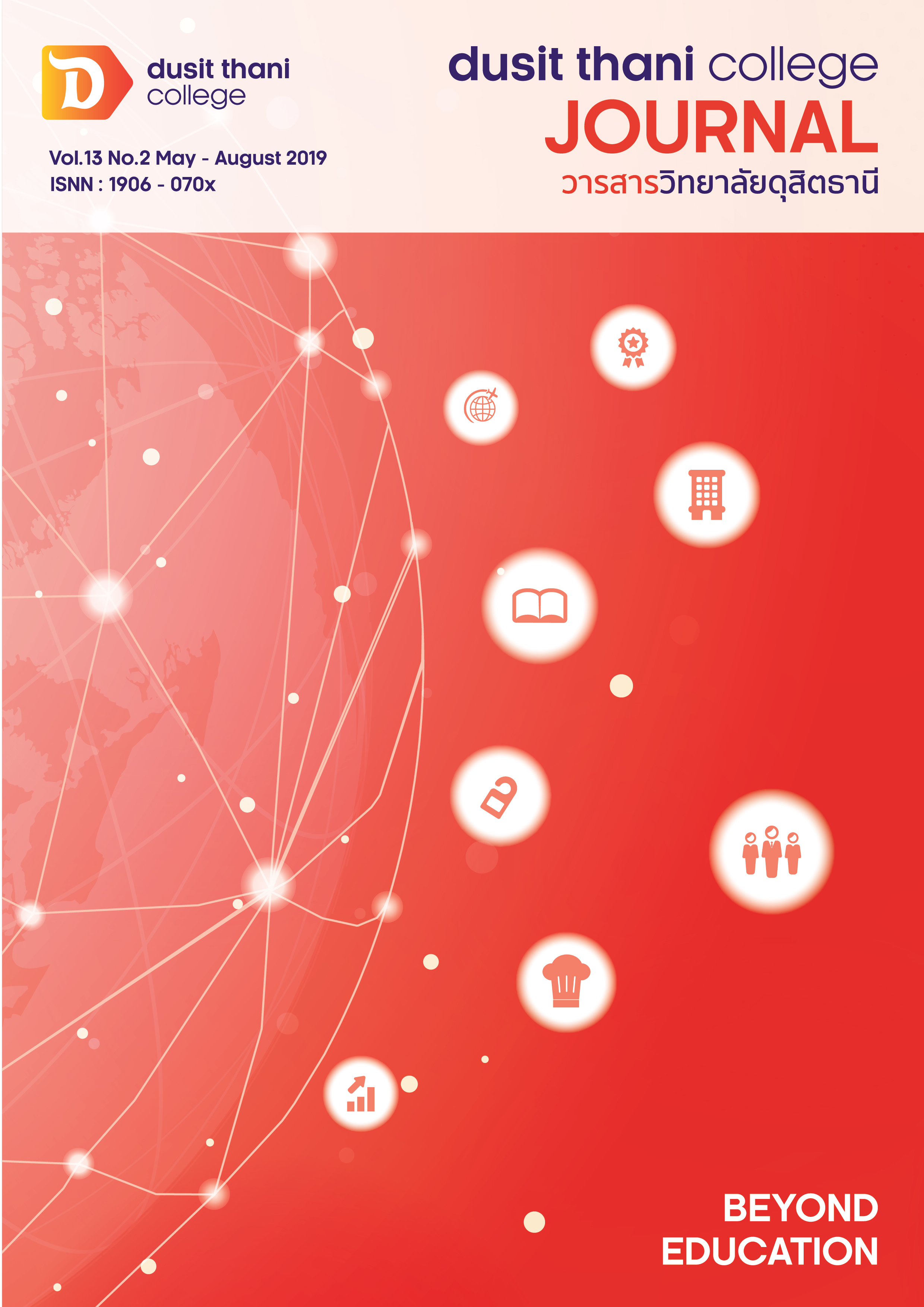ความสัมพันธ์ระหว่างคุณภาพชีวิตในการทำงานและความผูกพันต่อองค์กร ของพนักงานสายการบินฝ่ายปฏิบัติงานภาคพื้นดิน : กรณีศึกษาสายการบินไทยไลอ้อนแอร์
Main Article Content
บทคัดย่อ
งานวิจัยครั้งนี้มีวัตถุประสงค์เพื่อศึกษาความสัมพันธ์ระหว่างคุณภาพชีวิตในการทำงานและความผูกพันต่อองค์กรของพนักงานปฏิบัติงานภาคพื้นดิน สายการบินไทยไลอ้อนแอร์ โดยเก็บข้อมูลจากกลุ่มประชากรที่เป็นพนักงานปฏิบัติงานภาคพื้นดิน สายการบินไทยไลอ้อนแอร์ จำนวน 400 คน โดยใช้แบบสอบถามเป็นเครื่องมือในการเก็บรวบรวมข้อมูล สถิติที่ใช้ผู้วิจัยใช้สถิติเชิงพรรณนา เพื่อใช้ในการพรรณาข้อมูลทั่วไปของกลุ่มตัวอย่างรวมทั้งระดับคุณภาพชีวิต และ ใช้สถิติเชิงอนุมาน (Inferential Statistics) โดยการวิเคราะห์สหสัมพันธ์เพียร์สัน เพื่อเป็นการทดสอบความสัมพันธ์กันระหว่างตัวแปรสองตัวแปร และใช้การวิเคราะห์การถดถอยพหุคูณแบบขั้นตอน เพื่อวิเคราะห์ว่าองค์ประกอบคุณภาพชีวิตในการทำงานใดบ้างที่จะก่อให้เกิดความผูกพันต่อองค์กร ในการทดสอบสมมติฐาน พบว่า ระดับคุณภาพชีวิตในการทำงานของพนักงานฝ่ายปฏิบัติงานภาคพื้นดินสายการบินไทยไลอ้อนแอร์ โดยรวมอยู่ในเชิงบวกระดับปานกลาง และระดับความสัมพันธ์โดยรวมระหว่างคุณภาพชีวิตในการทำงานกับความผูกพันต่อองค์การของพนักงานปฏิบัติงานภาคพื้นดิน สายการบิน ไลอ้อนแอร์ มีความสัมพันธ์กันอย่างมีนัยสำคัญทางสถิติโดยมีความสัมพันธ์กันในเชิงบวกระดับสูง และองค์ประกอบด้านคุณภาพชีวิตในการทำงานที่มีความสัมพันธ์กับความผูกพันต่อองค์การมีอยู่ 5 องค์ประกอบ ได้แก่ ด้านสภาพการทำงานที่ปลอดภัยและส่งเสริมสุขภาพ ด้านโอกาสความก้าวหน้าความมั่นคงในงาน ด้านค่าตอบแทนที่เพียงพอและยุติธรรม ด้านโอกาสในการพัฒนาและการใช้ความสามารถของบุคคล และ ด้านความสมดุลระหว่างชีวิตการทำงานกับชีวิตส่วนตัว โดยมีความสัมพันธ์อย่างมีนัยยะสำคัญกับความผูกพันต่อองค์การ จากผลการศึกษาชี้ให้เห็นได้ว่า องค์การควรให้ความสำคัญกับการเสริมสร้าง คุณภาพชีวิตในการทำงานเพื่อให้บุคลากรมีความผูกพันต่อองค์การมากขึ้น ซึ่งความผูกพันต่อองค์การจะส่งผลให้พนักงานมีความรู้สึกที่อยากจะทำงานต่อไปในองค์การโดยไม่คิดจะลาออก ดังนั้นคุณภาพชีวิตในการทำงานด้านที่มีความสัมพันธ์กับความผูกพันองค์การควรได้รับการเอาใจใส่ให้ความสำคัญและในด้านที่ยังขาดก็ควรมีการพัฒนาปรับปรุงด้านนโยบายและการบริหารงานให้ดียิ่งขึ้น เพื่อเป็นการสร้างคุณภาพชีวิตของพนักงานและพัฒนาองค์การต่อไป
Article Details
นโยบายการพิจารณากลั่นกรองบทความ
- บทความวิจัยและบทความวิชาการทุกเรื่องที่จะได้รับการตีพิมพ์ต้องผ่านการพิจารณากลั่นกรองโดยผู้ทรงคุณวุฒิ (Peer Review) ในสาขาที่เกี่ยวข้อง จำนวน 3 ท่าน/บทความ
- บทความ ข้อความ ภาพประกอบและตารางประกอบที่ลงตีพิมพ์ในวารสารเป็นความคิดเห็นส่วนตัวของผู้เขียน กองบรรณาธิการไม่จำเป็นต้องเห็นด้วยเสมอไป และไม่มีส่วนรับผิดชอบใด ๆ ถือเป็นความรับผิดชอบของผู้เขียนแต่เพียงผู้เดียว
- บทความที่จะได้รับการตีพิมพ์จะต้องไม่เคยตีพิมพ์ เผยแพร่ที่ใดมาก่อน และไม่อยู่ระหว่างการพิจารณาของวารสารฉบับอื่น หากตรวจสอบพบว่ามีการตีพิมพ์ซ้ำซ้อน ถือเป็นความรับผิดชอบของผู้เขียนแต่เพียงผู้เดียว
- บทความใดที่ผู้อ่านเห็นว่าได้มีการลอกเลียนหรือแอบอ้างโดยปราศจากการอ้างอิง หรือทำให้เข้าใจผิดว่าเป็นผลงานของผู้เขียน กรุณาแจ้งให้กองบรรณาธิการวารสารทราบจะเป็นพระคุณยิ่ง
เอกสารอ้างอิง
Received Fringe Benefit of Staff of Thai Airways International (Public Company Ltd.): A Case Study of Human Resources and General Management Department. Master of Arts (Social Development). National Institute of Development Administration. (in Thai)
2. Tobarameegul, N. Factors of the Quality of Working Life Effecting Organization Commitment of Thanachat Bank employee Central Office 3. Master of education Program in Development Education. Silpakorn University. (in Thai)
3. Suntiwongs, T. Organization behaviour. 2th ed. Bangkok: Thai Wattana Panich Press.
(in Thai)
4. Treeprasitchai, T. (2557). Factors Affecting Employee Retention of Five-star Hotels in Bangkok. M.A. (Hospitality and Tourism Industry Management), Graduate School, Bangkok University. (in Thai)
5. Limyothin, P. (2555). Structural Equation Model of Factors Influencing the Hotel Staff in Thailand's Intention to Quit. Doctor of Philosophy in Management. Prince of
Songkla University. (in Thai)
6. Pansumnieng, P. (2555). A study of quality of work life and perception of organizational justice affecting organizational citizenship behavior through employees' engagement of support staff: a case study of faculty of medicine one of Bangkok. Master of Arts Program of Public and Private Management. Graduate School. Silpakorn University. (in Thai)
7. Phongpairoje, W. (2558). A Study of the Relationship between Quality of Work Life and Organization commitment: A Case Study of among Professional Nurse Out-Patients Department in A University Hospital. Master of Arts Program of Public and Private Management. Graduate School. Silpakorn University. (in Thai)
8. Kasemsil, S. (2519).Administration. Bangkok: Thai WattanaPanich Press. (in Thai)
9. Morarit, S. (2557).Quality of Work Life and Organization Commitment of Health Personnel Regional Health Promoting Center 10 Chiang Mai. Lanna public health journal (January-April) : 34-37. (in Thai)
10. Naweekarn, S. (2546.). Management and organizational behavior. . Bangkok: Bhannakij 1991 Press. (in Thai)
11. Becker, H. (1960). Notes on the Concept of Commitment. / American Journal Sociology 66, 1(July) : 32-42.
12. Bluestone, I. (1997). Organization Citizenship Behaviour Among Hospital Employees. A Multidimensional Analysis Involving Job Satisfaction and Organization Commitment. / Hospital and Health Service Administration 42 (summer): 221-262.
13. Cronbach, Lee. J. (1990). Essentials of Psychology Testing. 5th ed. New York: Harper Collins Publishers Inc.
14. Herzberg, F. (1968). One more time: how do you motivate employees. Harvard Business Review, January–February :109–20
15. Huse, E.F. and Thomas G. Cummings. (1985). Organization development and change.
(3rd ed.). Minnesota: West Publishing.
16. Joren,s. (2015). Feasibility Analysis of a Low-Cost Strategy for Long Distance Flight. Book on Demand GmbH, Norderstedt Germany.Pp:27.
17. Lawler, E.E., III. (1971). Pay and organizational effectiveness: a psychological view. New York: McGrawHill.
18. Maslow, A. H. (1943). A theory of human Motivation. Psychological Review, 50, 370-396.
19. Mayo, E. (1949) The Social Problems of Industrial Civilization: Routledge and Kegan Paul.
20. Mowday,R. (1998). Reflections on the study and relevance of organizational commitment. Human. Human Resource Management Review, 8(4), 387-401.
21. Steers, R. M. (1977). Antecedents and outcomes of organizational commitment/ Administrative Science Quarterly 22: 46-56.
22. Walton, Richard E. (1974). Improving the Quality of Working Life. Harvard Business Review 52 (May-June): 12.


